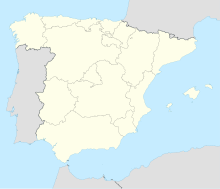Calar Alto Observatory
The Calar Alto Observatory is a German-Spanish observatory on the 2168 m high Calar Alto in the Sierra de los Filabres in southern Spain ( Almería province ). The official name is German-Spanish Astronomical Center (DSAZ) or in Spanish Centro Astronómico Hispano-Alemán (CAHA) .
Telescopes
There are five large optical mirror telescopes on Calar Alto :
- 3.5 m telescope (since 1984). It is the largest reflector telescope in Western Europe. The companies Schott ( Zerodur ) and Zeiss were involved in the construction.
- 2.2 m telescope (since 1979)
- 1.23 m telescope (since 1975)
- Schmidt telescope with 80 cm entrance opening and 1.20 m mirror diameter (out of service since 2000). This telescope, which was originally operated at the Hamburg observatory from 1954 , was moved to Calar Alto in 1975 with its better weather conditions.
- Spanish 1.52 m telescope (operated independently by the Spanish State Observatory Madrid (OAN))
history
Coordinates: 37 ° 13 '25 " N , 2 ° 32' 46" W.
The construction of the observatory on Calar Alto goes back to a memorandum of the German Research Foundation on the state of astronomy from 1962. This memorandum suggested the construction of a large radio telescope (later built as the Effelsberg radio telescope near Effelsberg ) and a large optical observatory in a region with a favorable climate to compensate for the lag in observational astronomy in Germany after the Second World War . Both projects could actually be realized.
In 1967 the Senate of the Max Planck Society decided to set up the Max Planck Institute for Astronomy in Heidelberg as the sponsor of such a large observatory. An observatory in the Mediterranean area and one in the southern hemisphere were planned, each with a 2.2 m telescope and a 3.5 m telescope at one of the two locations. For a long time, the Gamsberg near Windhoek in what is now Namibia was intended as a southern location. But these plans were never realized for political reasons, the second 2.2-m telescope was therefore later at the La Silla Observatory of ESO erected.
The 3.5 m telescope, like the northern 2.2 m telescope and smaller telescopes, went to the northern location for which the Calar Alto north of Almería was selected.
On September 28, 1979, the Calar Alto Observatory was officially opened by King Juan Carlos I of Spain. During the first 25 years the telescopes were mainly available to German and only a small part of Spanish astronomers.
As of January 1, 2005, the Calar Alto Observatory will be jointly operated by the Max Planck Institute for Astronomy and the Andalusian Institute for Astrophysics (IAA ) based on a cooperation agreement between the Max Planck Society (MPG) and the Spanish Science Council (CSIC) ) operated in Granada ; the telescopes were thus available to both partners for 50% of the time. Several scientists from the observatory, along with colleagues from various other observatories in ten countries, were involved in the discovery and exploration of the supermassive black hole in quasar OJ 287 .
On May 23, 2019, the regional government of Andalusia and the MPG signed a transfer agreement for the 50% share in the observatory. Since then it has been exclusively in Spanish ownership.
Web links
- Homepage of the Calar Alto Observatory
- Jan Hattenbach: Spain's astronomers in need of money . April 2013. Retrieved on June 25, 2014., FAZ "Wissen"
Individual evidence
- ↑ https://www.flickr.com/photos/raindogjones/9217295422/sizes/l
- ↑ see data on this memorandum from 1962 in the DNB at http://d-nb.info/450904768
- ↑ Junta de Andalucía and the Max Planck Institute make official the transfer of 50% of the Calar Alto Observatory. Retrieved July 17, 2019 .

